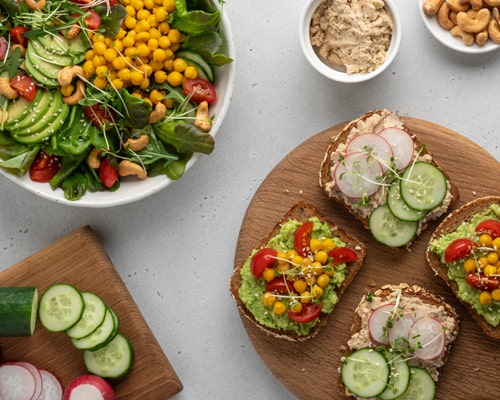Are Food Additives Making You Sick?
- 10/31/16

While many Americans pledge to themselves to “eat well”, it is often too easy to reach for a quick, packaged dinner after a long day at the office or running errands. Frequently, these packaged meals and side dishes are even disguised as “healthy”—such as frozen broccoli or instant rice pilaf. However, a closer look at the label often will show hidden food additives listed in the ingredients, such as those used for coloring, to enhance flavor and/or texture, or added for preservative purposes. Unfortunately, those additives may have harmful risks and side effects that can have a very detrimental impact on health.
Perhaps the most notorious of all food additives are trans fats, intended to be used as a substitute for butter, lard and coconut oil. These manufactured fats extend the shelf life of products, and are often phrased as “partially hydrogenated vegetable oil” and “vegetable shortening”. Present in margarine, commercially baked goods, frozen foods, soups, crackers and many other processed foods, trans fats have been found to be a direct contributor to heart disease. Harvard School of Public Health researchers first discovered the ill effects of trans fats, and in 2006, the U.S. began requiring stricter food labeling to identify trans fats. According to the Mayo Clinic, trans fats raise the body’s level of LDL ("bad") cholesterol and lower HDL ("good") cholesterol—thus increasing the risk of heart disease. Since foods containing less than 0.5 grams of trans fat are allowed to be labeled as 0 grams trans fat, it is especially important to check the ingredient list.
Emulsifiers are another widely used food additive that also extend shelf life, plus are used to thicken and add texture to foods. Listed on labels as carboxymethycellulose, polysorbate 80, lecithin, carrageenan, polyglycerols, and xanthan and other “gums,” emulsifiers are found in salad dressing, mayonnaise, ice cream, yogurt, pudding, cheese and many other packaged foods. Georgia State University researchers conducted a study and found that even low concentrations of emulsifiers can drastically disrupt gut bacteria. Supported by contributions from Emory University, Cornell University and Bar-Ilan University in Israel, the study findings published in Nature showed that the alteration of gut microbiota induced intestinal inflammation. This was found to be linked to the development of inflammatory bowel disease and metabolic syndrome. With findings like these, it is of little surprise that diseases like IBS, Crohn’s disease and ulcerative colitis are on the rise—along with type-2 diabetes, cardiovascular disease and other obesity-related disorders linked to metabolic syndrome.
While heart disease, obesity and digestive disorders are troubling enough, food additives can also cause a different kind of harm, especially in children. Artificial dyes have been known to cause hyperactivity in children with attention deficit disorder (ADHD), according to studies published in The Lancet, Pediatrics, and Journal of Pediatrics. Specifically, Red #40, Blue #2, Yellow #5 (Tartrazine), Yellow #6 (Sunset Yellow), as well as the preservative sodium benzoate, are common culprits in disrupting focus and causing relentless fidgeting. Colorful cereal is a top source of artificial dye, along with less obvious foods like barbeque sauce, cake mixes, and fruit punches.
The list of additives in foods seems almost endless. From high fructose corn syrup and excess salt in breads to nitrates in packaged deli meats, caution needs to be exercised in almost every food category. Beyond having negative side effects, processed foods are many times depleted of vital nutrients that the body needs. These include soluble fiber, antioxidants and “good” fats.
The best way to avoid additives and ensure good nutrition is to eat fresh, clean, whole foods whenever possible. In addition, choosing organic food takes away the risk of eating GMOs, toxic pesticides, antibiotics and growth hormones. Meat, dairy, and eggs are especially important to eat organic. The 2015 version of the Shoppers’ Guide to Pesticides in Produce identified the produce to always choose organic, as they have the highest risk of pesticide contamination. The “Dirty Dozen Plus” list includes apples, peaches, nectarines, strawberries, grapes, celery, spinach, sweet bell peppers, cucumbers, cherry tomatoes, snap peas, potatoes, hot peppers, kale and collard greens. While it may be more expensive to eat fresh, organic foods, it is wise to consider eating well as an investment in your body and your long-term health.
Perhaps the most notorious of all food additives are trans fats, intended to be used as a substitute for butter, lard and coconut oil. These manufactured fats extend the shelf life of products, and are often phrased as “partially hydrogenated vegetable oil” and “vegetable shortening”. Present in margarine, commercially baked goods, frozen foods, soups, crackers and many other processed foods, trans fats have been found to be a direct contributor to heart disease. Harvard School of Public Health researchers first discovered the ill effects of trans fats, and in 2006, the U.S. began requiring stricter food labeling to identify trans fats. According to the Mayo Clinic, trans fats raise the body’s level of LDL ("bad") cholesterol and lower HDL ("good") cholesterol—thus increasing the risk of heart disease. Since foods containing less than 0.5 grams of trans fat are allowed to be labeled as 0 grams trans fat, it is especially important to check the ingredient list.
Emulsifiers are another widely used food additive that also extend shelf life, plus are used to thicken and add texture to foods. Listed on labels as carboxymethycellulose, polysorbate 80, lecithin, carrageenan, polyglycerols, and xanthan and other “gums,” emulsifiers are found in salad dressing, mayonnaise, ice cream, yogurt, pudding, cheese and many other packaged foods. Georgia State University researchers conducted a study and found that even low concentrations of emulsifiers can drastically disrupt gut bacteria. Supported by contributions from Emory University, Cornell University and Bar-Ilan University in Israel, the study findings published in Nature showed that the alteration of gut microbiota induced intestinal inflammation. This was found to be linked to the development of inflammatory bowel disease and metabolic syndrome. With findings like these, it is of little surprise that diseases like IBS, Crohn’s disease and ulcerative colitis are on the rise—along with type-2 diabetes, cardiovascular disease and other obesity-related disorders linked to metabolic syndrome.
While heart disease, obesity and digestive disorders are troubling enough, food additives can also cause a different kind of harm, especially in children. Artificial dyes have been known to cause hyperactivity in children with attention deficit disorder (ADHD), according to studies published in The Lancet, Pediatrics, and Journal of Pediatrics. Specifically, Red #40, Blue #2, Yellow #5 (Tartrazine), Yellow #6 (Sunset Yellow), as well as the preservative sodium benzoate, are common culprits in disrupting focus and causing relentless fidgeting. Colorful cereal is a top source of artificial dye, along with less obvious foods like barbeque sauce, cake mixes, and fruit punches.
The list of additives in foods seems almost endless. From high fructose corn syrup and excess salt in breads to nitrates in packaged deli meats, caution needs to be exercised in almost every food category. Beyond having negative side effects, processed foods are many times depleted of vital nutrients that the body needs. These include soluble fiber, antioxidants and “good” fats.
The best way to avoid additives and ensure good nutrition is to eat fresh, clean, whole foods whenever possible. In addition, choosing organic food takes away the risk of eating GMOs, toxic pesticides, antibiotics and growth hormones. Meat, dairy, and eggs are especially important to eat organic. The 2015 version of the Shoppers’ Guide to Pesticides in Produce identified the produce to always choose organic, as they have the highest risk of pesticide contamination. The “Dirty Dozen Plus” list includes apples, peaches, nectarines, strawberries, grapes, celery, spinach, sweet bell peppers, cucumbers, cherry tomatoes, snap peas, potatoes, hot peppers, kale and collard greens. While it may be more expensive to eat fresh, organic foods, it is wise to consider eating well as an investment in your body and your long-term health.




